










FEB. 13, 2025
STEVIN KAMWENDP
Contributor Kash Patel, the Trump administration’s pick for FBI director and graduate of the University’s law school, has come under increasing scrutiny after filling out a senate questionnaire earlier this month and attending a confirmation hearing on Thursday, Jan. 30. These recent events have renewed interest in the FBI candidate’s background, especially the University’s role in his career, a factor which it has decided to stay silent on.
Following President Donald Trump’s inauguration, the Republican party has been gathering its nominees for government and civil sector positions and is preparing to install them for the Trump administration’s second term. Among the nominees chosen is Kashyap “Kash” Patel, former Department Of Justice (DOJ) prosecutor and Chief of Staff to the Secretary of Defense. Patel has built political support among conservatives over the last few years, aligning himself with GOP policies. He has promised that as FBI director, he will restructure the agency, arguing that it has unfairly targeted conservatives. Today, he is recognized as a loyalist to Trump and a prominent member of his cabinet lineup.
The questionnaire–given to the Senate earlier this month–revealed information about the prospective FBI director’s upbringing and educational background. In it, Patel details attending the University of Richmond, where he earned his bachelor’s degree in criminal justice and history. He also mentions receiving a Certificate in Inter national Law from the University College London in 2004. What is particularly enlightening in the questionnaire is his recollection of his time as a student at the Elizabeth Haub School of Law at the University.
The document notes that Patel participated in the American Bar Association’s Judicial Intern Opportunity during the summer of 2003. However, relatively little is known about his time at the University beyond this. He has
made a few other vague statements pertaining to his time there. In his 2023 publication “Government Gangsters: The Deep State, the Truth, and the Battle for Our Democracy,” Patel wrote, “I got bad grades in law school,” providing a small glimpse into his habits as a student. Despite this, the nature of his education is still incredibly foggy, and his impact on the University isn’t as widely recognized as that of other alumni like Robert F. Kennedy Jr.
When asked for a statement on the prospect of Patel becoming director of the FBI and what it could mean for the University going forward, the Elizabeth Haub School declined to comment. Similarly, when asking professors for comments on Patel and how he may have been as a student, those who responded had very little to say. Very few of the professors who were present at the University’s law school and interacted with Patel remain. However, one professor–who requested to remain anonymous–expressed, “It is, naturally, always good to hear that our alumni are being considered for positions of national prominence.”
Since his time at the Elizabeth Haub School, Patel has had an extensive career in law. Patel served as both a public and federal defender in Florida in the 9 years following his graduation before rising to higher positions, such as his role as a terrorism prosecutor in the National Security Division of the DOJ. Patel joined the Trump administration during its first term in 2019, overseeing the National Security Council and serving as Chief of Staff to former Secretary of Defense Mark Esper. Throughout Joe Biden’s presidency, Patel continued to show his intent to work with the GOP through interviews and other media appearances, such as political podcasts. These appearances have been quite controversial, as Patel maintains the claim that the FBI and other sectors of government have been converted by the “deep state” and are in need of reform.
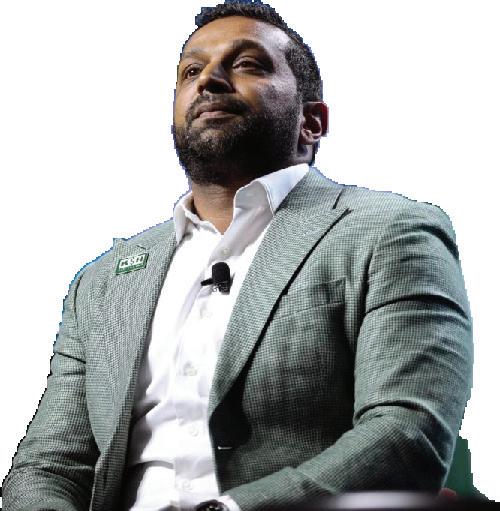
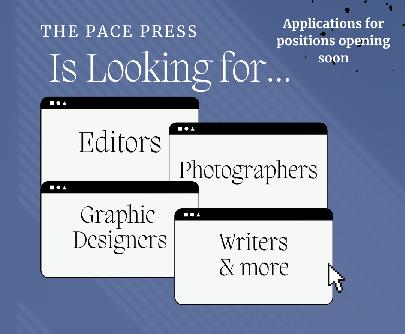
FEB. 14, 2025
NICHOLAS COVONE
Columnist
On Feb. 9, the 2024-2025 National Football League (NFL) season came to a thrilling conclusion as the Philadelphia Eagles soared to a 40-22 victory over the Kansas City Chiefs in Super Bowl LIX. In a rematch of Super Bowl LVII–where the Chiefs defeated the Eagles 38-35–Philadelphia seized their second Lombardi Trophy, crushing the Chiefs three-peat hopes in the process.
The first quarter opened with punts from both teams on their first possessions. The scoring started with six minutes left in the first. Eagles quarterback (QB) Jalen Hurts launched a deep pass to wide receiver (WR) Jahan Dotson, setting up a quarterback sneak at the one-yard line for the opening touchdown. The first quarter would end 7-0 Philadelphia.
Early in the second quarter, Hurts pass was intercepted by Chiefs safety (S) Bryan Cook at the two-yard line. However, the Eagles’ defense quickly regrouped, forcing a three-and-out that set up kicker Jake Elliott to extend the lead to 10-0 with a 48-yard field goal. The Chiefs’ next drive opened with back-toback sacks by Eagles linebacker (LB) Josh Sweat and rookie LB Jalyx Hunt. On third down, rookie cornerback (CB) Cooper DeJean picked off Chiefs quarterback Patrick Mahomes, returning the interception 38 yards to give the Eagles a 17-0 lead with seven minutes left in the quarter. The Eagles defense forced another three-and-out with a sack from defensive tackle (DT) Milton Williams. Although the Chiefs’ defense stopped the Eagles briefly with a punt, Eagles LB Zack Baun then made a crucial diving interception with just 1:45 remaining in the half. The turnover set up a 12-yard touchdown pass from Hurts to WR A.J. Brown to put the Eagles up 24-0. Ending a dominant first half from the Eagles, scoring 24 points and holding the Chiefs to 23 total yards.
The Chiefs started the second half with some offensive momentum, but back-to-back sacks from DT Jordan Davis and LB Josh Sweat halted their drive. The Eagles had another impressive drive, padding their lead with a 29-yard field goal to make the score 27-0. The Chiefs once again were gaining some momentum but were stopped on fourth-and-three to put the Eagles at the Chiefs’ 46-yard line. On the first play of the drive, Hurts threw a 46-yard touchdown pass to WR DeVonta Smith, extending the Eagles lead to 34-0. On the Chiefs’ next drive, they ended the Eagles’ shutout hopes, as Mahomes threw a 24-yard touchdown pass to rookie WR Xavier Worthy. However, the Chiefs failed on a two-point conversion attempt, ending the third quarter with a score of 34-6.
In the fourth quarter, the Eagles continued to grow their lead. With 9:51 left on the clock, Jake Elliott nailed a 48-yard field goal, pushing the score to 37-6. A minute later, Elliott added a 50-yarder to extend the margin to 40-6. The Chiefs began a late rally, as Mahomes connected for a seven-yard touchdown to WR DeAndre Hopkins and a successful twopoint conversion to cut the lead to 40-14 with 2:54 remaining. However, Mahomes sparked one final drive, launching a 50-yard touchdown pass to Worthy, and another two-point conversion put the game away at 40-22, sealing the Eagles’ Super Bowl victory as time expired.
This is the Philadelphia Eagles’ second Super Bowl victory in franchise history, their first coming in Super Bowl LII.
After his impressive performance, 26-year-old Eagles Quarterback Jalen Hurts was named the Super Bowl Most Valuable Player (MVP). Hurts completed 17 of 22 passes for 221 yards, two passing touchdowns, 72 rushing yards and one rushing touchdown.
The Eagles’ Super Bowl victory parade will be held on Friday, Feb. 14. Philadelphia officials expect a turnout of over one million people to celebrate the team’s second Lombardi Trophy.
Donald Trump puts an end to Diversity, Equity, and Inclusion policies across federal departments by executive order on his first day in office.
SAMANTHA CHESNEY Contributor In an executive order (EO) entitled “Ending Radical and Wasteful Government DEI Programs and Preferencing” (EO 14151) signed on Jan. 20, President Trump ordered the termination of all programs, mandates and policies that promote the ideals of Diversity, Equity and Inclusion (DEI).
DEI policy was originally introduced through executive order by former President Biden on his first day in office. Biden’s executive order, “Advancing Racial Equity and Support for Underserved Communities Through the Federal Government” (EO 13985), “recognized that, although the ideal of equal opportunity is the bedrock of American democracy, our laws, public policies, and institutions too often exacerbate disparities or deny equal opportunity to individuals and communities.” In President Trump’s executive order, Biden’s policy is described as “illegal and immoral discrimination programs.”
Through the repealing of DEI policy, the executive order appoints the Director of the Office of Management and Budget, Russell Vought, to review and revise “all existing Federal employment practices, union contracts, and training policies or programs to comply with this order. Federal employment practic-
MARCH 1, 2025
es, including Federal employee performance reviews, shall reward individual initiative, skills, performance, and hard work and shall not under any circumstances consider DEI.”
In a fact sheet released by the White House Press Office regarding Trump’s executive order, it states, “This Executive Order reaffirms these values [individual dignity, hard work and excellence] by ending the Biden-Harris Administration’s anti-constitutional and deeply demeaning ‘equity’ mandates, terminating DEI and protecting civil rights.”
More recently, on Feb. 21, U.S. District Judge Adam Abelson issued a preliminary injunction against multiple provisions of the executive order. An injunction is a special court order which compels a party to do or refrain from doing certain acts. Preliminary injunctions are given before a trial (because of this, they are rarely given) with the additional requirement that the party asking for the injunction is likely to succeed on its merits.
Abelson argues that the order failed to define DEI terms, making itself too vague for federal employees to reasonably determine their compliance. Abelson also noted that the order could potentially discourage businesses, organizations and public entities from openly supporting diversity, equity and inclusion.
These effects are already being seen throughout the American markets. Forbespublished a frequently updated list of companies that cut their DEI programs and/or policies. One example from this list, dated Feb. 26, is the American film production and distribution company Paramount. Forbes reports, “Paramount will no longer use diversity targets—tied to race or gender—in hiring, and the company has begun removing DEI language from its website, the New York Times and other outlets reported, citing a company memo in which Paramount executives cited Trump’s anti-DEI executive orders.”
However, news organizations and publications are not the only ones reporting on corporate DEI repeals. In the days following President Trump’s executive order, thousands of social media users have taken to platforms such as Instagram, TikTok and X to call for the boycott of companies that scale back their DEI initiative. These companies include Target, Walmart, Amazon, Tesla, Google and many others.
Supporters of the boycott have also encouraged consumers to shop at Costco and other retailers who have continued their commitments to diversity efforts despite Trump’s executive order.
MARCH 14, 2025
MAKHI
BASNIGHT Contributor
New York City Mayor Eric Adams has recently made history; he is the first NYC mayor to be indicted while in office. Last September, Adams was charged with five counts of corruption, bribery and fraud. He has allegedly pressured officials to approve paperwork for a skyscraper that Turkish government officials inhabit in exchange for luxurious goods, services and donations to his campaign. Adams denies these claims. To his rescue, Attorney General Emil Bove (appointed by Trump) has ordered prosecutors to drop Adams’ charges in exchange for his participation in implementing President Trump’s latest policies.
Adams is no stranger to criticism. Since being elected, he has faced much backlash for his obnoxious ways. Typically, the backlash he faces is more trivial, like the commentary on his nightlife behavior, but the stakes have never been this high. On Sep. 26, 2024, the indictment against Adams was unsealed; it was revealed he had been hit with five criminal charges, including two counts of solicitation of campaign funds from a foreign country, one count of conspiracy against the United States, one count of wire fraud and one count of soliciting and accepting a bribe. The investigation on the New York mayor began a year prior when his electronics were seized to establish a connection between him, Turkey officials and the Brooklyn contractors for said skyscraper.
Since then, there has been a wave of resignations from his administration that has raised many eyebrows. Despite the compelling evidence and the optics, Adams doubled down and pleaded not guilty on Sep. 27, 2024. He also refuses to step down from his position. “His refusal to step down raises crucial questions about stability and trust in his leadership,” Darius Phelps of the University’s English language and literature department said. “This sets a dangerous precedent.”
Oddly enough, in the heat of controversy, Adams made time to attend a UFC
event with President Trump and other Republican leaders, despite it not being within Adams’ schedule or although Adams was listed as a Democrat. Since then, Adams has attended many of President Trump’s events, including his inauguration. Trump has spoken out in defense of Adams; he believes the accusations are all politically motivated because Adams was not fond of former President Biden. Mayor Adams denies a friendship with Trump. He states that they have only “exchanged pleasantries.”
Following the Department of Justice (DOJ)’s executive order instructing for the charges against Mayor Adams to be dropped, Danielle Sassoon, former head of the Southern District of New York, has joined the long list of resignations after the Adams scandal. Sassoon’s resignation is not a form of concession but more of power; it is in protest. “Because the law does not support a dismissal, and because I am confident that Adams has committed the crimes with which he is charged, I cannot agree to seek a dismissal driven by improper considerations,” Sassoon states. She believes that the order from the DOJ is a gross use of power and is an apparent act of quid pro quo. Mayor Adams and President Trump deny these claims. The DOJ believes that the case is interfering with his ability to serve as acting mayor of the city.
The Department of Justice has filed against New York for the charges to be formally dropped. Even if Adams avoids jail time, he will still be in an uphill battle as he vies for reelection come Nov. 2025. Many, like Eric English, professor of the University’s Communications and Media Studies department, believe he is “compromised… and legal action needs to be taken to restore the city to a competent and uncorrupt leadership.” Most New Yorkers and city officials are calling for him to resign, as his poll numbers have hit an all-time low at an approval rate of 20 percent, which is a new low in almost 30 years for any NYC Mayor. If anything, he’s consistent.
FEB. 12, 2025
SABRINA CROWLEY Assistant News Editor
On Wednesday, Feb. 5, a protest titled “Reject Project 2025” was held at City Hall Park, right next to the University. The initial flyer for the protest says, “50 protests, 50 states, one day,” giving it the title of the 50501 protest. People gathered in City Hall Park to stand up for immigrants, diversity, trans rights, civil servants, science and the Constitution, as stated on the flyer.
Project 2025 is a political initiative designed to reshape the federal government of the United States and remove checks on executive powers in favor of right-wing policies. The conservative government plan lists different policies that may be added, removed or changed during the implementation process.
During the protest, crowds gathered around the park’s fountain holding signs while chanting various phrases, including “The people united will never be defeated.” Many representatives from the Revcom Corps for the Emancipation of Humanity were also present, distributing flyers and answering questions.
One of the flyers features a quote from the organization’s leader, Bob Avakian: “There is no good reason why the world has to be the way it is… A whole different way of living is possible: a whole different way to organize society, with a
radically different economic foundation and political system, emancipating relations among people and an uplifting culture–all of this oriented to meeting the basic needs and fulfilling the highest interests of the masses of people.”
Travis Morales, a representative of Revcom Corps, described the protest’s goals in more detail: “We’re here to reject the Project 2025 program and demand a new system. We don’t have to live this way… People are coming here to have a safe place to fight for their beliefs.”
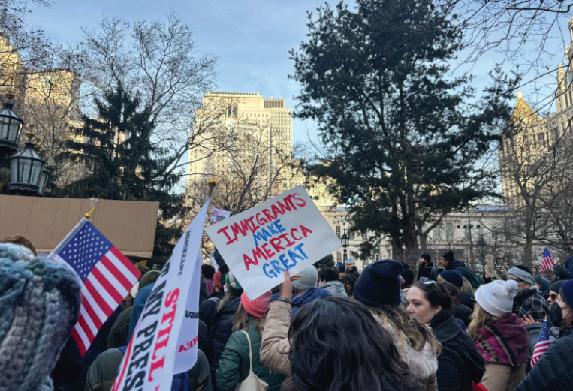
The protestors continued to assemble in the park, chanting sayings such as “Hate has no home here” and “Stand up, fight back.” They also brought in some of their political beliefs with sayings like “Trans Rights now,” “My body, my choice” and “Hands off Gaza.”
One protestor, Sarah Arvizo, is a New York native, but her parents immigrated to the United States from Mexico. “I am out here expressing my First Amendment right to free speech against what I believe is an unjust government… This administration goes against everything that I hold dear,” Arvizo said. The event lasted about two hours, and many different people came together to protest. To learn more about the Revcom Corps organization and Project 2025, please visit their respective websites.
JAN. 16, 2025
JULES KELLY Executive Editor
Visionary director, producer, actor and writer David Lynch passed away at 78, as shared by his family on social media on Thursday, Jan .16. While the cause of death has not been disclosed at this time, it was publicly revealed in Aug. 2024 that Lynch had been diagnosed with emphysema. Over his remarkable 58-year career, Lynch earned a reputation as one of the greatest filmmakers in American history, celebrated for his surreal direction and eerie, dreamlike storytelling. His distinctive style became so iconic that the Oxford English Dictionary officially recognized the term “Lynchian” as an adjective in 2018.
David Keith Lynch was born on Jan. 20, 1946, in Missoula, Montana and grew up in North Carolina, Idaho and Virginia. In 1967, he started attending the Pennsylvania Academy of the Fine Arts, where he met his first wife, Peggy Reavey, and had his first child. In the same year, he bought a second-hand Bolex camera and started making short films like “The Alphabet” and “The Grandmother,” which laid the foundation for Lynch’s signature oddness.
In 1970, Lynch, Reavey and their daughter moved to Los Angeles, where he studied filmmaking at the AFI Conservatory and started creating his first fulllength film, “Eraserhead.” Lynch received a $10,000 grant from the AFI, and the film production began in 1972. When the grant given was not enough to cover the film, Lynch loaned money from his father and started delivering a paper route of The Wall Street Journal for the remainder needed to complete the film.

“Eraserhead” was completed in 1976, and the film was submitted for screening at the Cannes Film Festival and New York Film Festival, where it was met with heavily mixed reviews and ultimately not chosen.
However, the film was screened at the Los Angeles Film Festival, where film producer and distributor Ben Barenholtz heard of and supported the movie. Barenholtz distributed “Eraserhead” around the United States, and the surrealist horror film became a cult classic for midnight movie showings.
Film producer Stuart Cornfeld saw a screening of “Eraserhead” and claimed, “I was just 100 percent blown away… I thought it was the greatest thing I'd ever seen. It was such a cleansing experience.” Afterward, Cornfeld found scripts for Lynch to direct, and upon hearing the title, Lynch ultimately chose “The Elephant Man.” The 1980 biographical film was a critical and commercial success, earning eight Academy Award nominations, including Best Director and Best Adapted Screenplay.
Following “The Elephant Man”’s success, “Star Wars” creator and director George Lucas offered Lynch the opportunity to direct “Return of the Jedi,” the third film in his original “Star Wars” trilogy. Lynch declined the offer, saying he had “next door to zero interest” in directing the film as he believed Lucas’ movie should reflect his own vision, not Lynch’s. Although he turned down one space epic, Lynch agreed to direct a film adaption of Frank Herbert’s “Dune” in 1984, plus two other movies for the production company De Laurentiis Entertainment Group (DEG). Lynch was unhappy with the film's final cut, with much of his footage being tampered with by studio executives and cut out to condense the film’s plot. In its release year, “Dune” was a critical and commercial flop, costing $45 million to make and only grossing $27.4 million domestically.
After the film’s failure, Lynch was still contractually obligated to produce two other projects for DEG. The first film, planned to be a sequel to “Dune,” was scrapped, while the other film was based on an original script Lynch had been working on since 1973, “Blue Velvet.” Lynch described the film as “a dream of strange desires wrapped inside a mystery story” and starred “Dune” lead Kyle MacLachlan, Isabella Rossellini, Dennis Hopper and Laura Dern. “Blue Velvet” quickly became a critical and commercial success due to the film’s controversy with audiences and critics, introduced Lynch to a mainstream audience and ultimately earned him a second Academy Award nomination for Best Director in 1986.
In 1989, Lynch met television producer Mark Frost, and the two started writing scripts together. None of their original ideas came to fru ition; however, while talking in a coffee shop, Lynch and Frost had the idea for a drama-thriller script about a corpse washing up on a lakeshore in a small town. They went to work on this project, initially called “Northwest Passage,” but was even tually changed to “Twin Peaks.” The duo pitched the series to ABC, which agreed to finance the pilot and eventually commissioned seven episodes.
Lynch directed two of the seven episodes of “Twin Peaks” and carefully selected the directors for the remaining five while simultaneously working on his Palme d'Or-winning film “Wild at Heart,” star ring Dern, Nicolas Cage and Willem Dafoe in 1990. For the first time since his short films in the 1960s, Lynch stepped in front of the camera, portraying the hard-ofhearing FBI agent Gordon Cole. With his distinctive cadence, Lynch brought a touch of comic relief to the series’ heavy plotlines and the conventions of standard police dramas.
“Twin Peaks” was a success, becoming a global phenomenon, and soon a second season of 22 episodes went into production. Still, ABC executives believed public interest in the show was declining, and the show was canceled after a ratings drop. Lynch, who disliked the direction the writers and directors took in the second season, directed the final episode and ended it with a cliffhanger, stating in an interview with Chris Rodley, “That's not the ending. That's the ending that people were stuck with.”
In 1992, Lynch returned to “Twin Peaks,” this time without Frost, to create a prequel (and somewhat of a sequel) film, “Twin Peaks: Fire Walk with Me.” The movie was much darker and more uncanny than the television show, and Lynch claimed it dealt with themes of “the loneliness, shame, guilt, confusion and devastation of the victim of incest.” The film was a commercial failure in the United States at the time of its release but has since become one of Lynch’s most popular works amongst fans.

In 2001, Lynch worked on a neo-noir mystery pilot about the dark side of Hollywood, which ultimately was developed into “Mullholand Drive” starring Naomi Watts and Justin Theroux. The film was another critical success, leading to Lynch winning Best Director at the 2001 Cannes Film Festival and being nominated for his third and final Academy Award for Best Director.
Following the success of “Mulholland Drive,” Lynch created and financed the most experimental film of his career in 2006, “Inland Empire.” With a three-hour runtime, the psychological thriller does not follow a traditional film structure, being shot without a finished screenplay and primarily developed on a scene-by-scene basis. “Inland Empire” premiered at Italy’s Venice Film Festival on Sep. 6, 2006, and Lynch also received the Golden Lion Lifetime Achievement Award for his “contributions to the art of cinema.”
Rumors circulated that Lynch would retire from traditional filmmaking after the release of “Inland Empire.” He continued to find himself behind the camera, though, directing a 16-minute short film for Dior in 2010, a concert film for new wave band Duran Duran and an animated short for New York rock band Interpol in 2011. The filmmaker also frequently appeared on “The Cleveland Show” as Gus the Bartender between 2008 and 2012.
Lynch dispelled the rumors of his retirement by returning to “Twin Peaks” once again in 2015 to create the Showtime sequel, “Twin Peaks: The Return.” The show featured an ensemble of new and returning characters and aired 18 episodes in 2017. The reboot was nominated for eight Emmy awards, including Outstanding Directing for a Limited or Anthology Series or Movie and Outstanding Writing for a Limited or Anthology Series or Movie. The same year, Lynch released the short film “What Did Jack Do?” on Netflix. He stated about his possible retirement, “I did not say I quit cinema, simply that nobody knows what the future holds.”
Lynch was a pioneer in many ways, including being one of the first filmmakers to distribute and premiere their own work on the internet, starting his website in Dec. 2001. Up until 2022, Lynch recorded and posted his own web series to YouTube, including “What is David Lynch Working on Today?” where he would make collages and “Today's Number Is...,” where each day he picks a random number from one to ten using a jar containing numbered ping-pong balls. Lynch’s most popular web series came in the form of weather reports, which he would record daily from his home in Los Angeles and share a song he was thinking about that day. He posted his final weather report on Dec. 16, 2022, at 76 years old, stating afterward, “Now I can sleep longer in the morning. I had to get up very early to consult the real weather bulletin. In two years, I have not missed a single
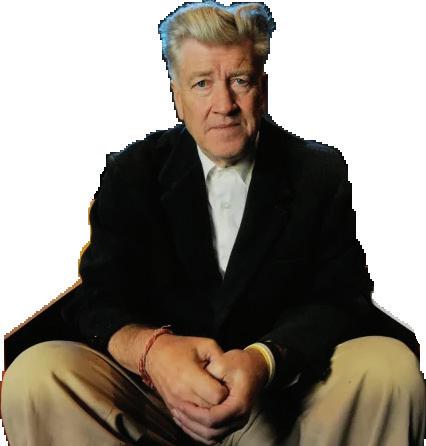
Lynch’s final work on screen came in 2022 when he portrayed director John Ford in Steven Spielberg’s semi-autobiographical film “The Fablemans.” According to Deadline, Lynch was hesitant about appearing in the movie, initially stating, “At first, I didn’t want to do it… And the reason is, when it comes to acting, I’ve purposely tried to stay away from it, giving the likes of Harrison Ford and George Clooney a chance at their careers.” However, Lynch agreed after Spielberg promised to meet his one request: leave a large bag of Cheetos in his dressing room.
Many friends and regulars in Lynch’s work shared their condolences, with MacLachlan sharing in a lengthy Instagram post, “His love for me and mine for him came out of the cosmic fate of two people who saw the best things about themselves in each other. I will miss him more than the limits of my language can tell and my heart can bear. My world is that much fuller because I knew him and that much emptier now that he’s gone.” Lynch’s family shared on Facebook, “There’s a big hole in the world now that he’s no longer with us. But, as he would say, ‘Keep your eye on the donut and not on the hole.’”
‘A
MARCH 4, 2025
ANAÏS DENUCCIO Secretary
“This thing is a movement,” E.B. White, an American writer best known for his children’s novels “Charlotte’s Web” and “Stuart Little,” wrote in a 1939 telegram to express the powerful spirit of The New Yorker. Now, decades later, the New York Public Library’s (NYPL) “A Century of The New Yorker” is bringing this movement to life by digging up hundreds of archives and presenting the magazine’s evolution.
The exhibition is on the third floor of the Stephan A. Schwarzman Building’s Rauner Special Collections Wing & Print Gallery on 5th Avenue, running through Feb. 21, 2026. If any students have studied at the NYPL, they know the third floor is known for its beautiful study rooms, and this free exhibition occupies the hallway directly across from those rooms, making it perfect for a short and sweet break. For much of The New Yorker’s history, its offices were just a few blocks from the NYPL, so it became a great resource. Since the magazine is renowned for its cover and cartoon art, artists, in particular, utilized the library’s Picture Collection often. The exhibit is divided into two sections: the first reveals The New Yorker’s origin stories, and the second explores its evolution into the modern, digital era. One of the most compelling sections of the exhibit is the “Anatomy of a Magazine” display, which shows the intricate processes behind every single issue.
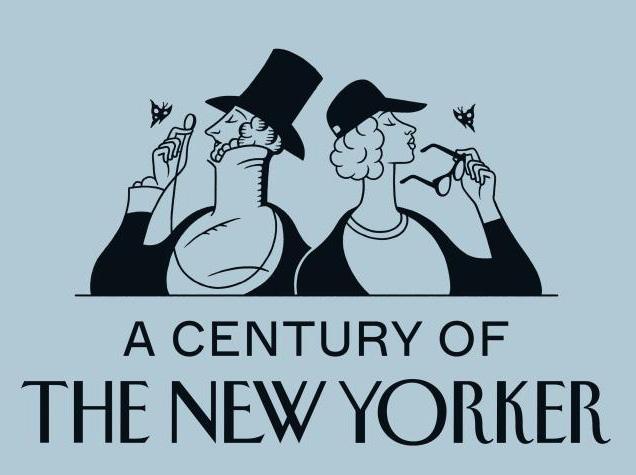
Image Sourced from nypl.org
to go behind the scenes to get.” During World War II, the magazine became a nationally influential publication. In fact, The New Yorker was among the first publications to address the rise of Adolf Hitler and condemn Germany. The exhibition also highlights the publication of John Hersey’s “Hiroshima,” a 30,000-word narrative in which Hersey, one of the first American journalists to reach Hiroshima after the bombing, documented the experiences of several survivors. However, before The New Yorker hit this trajectory of influence and recognition, the magazine was on the brink of failure due to financial difficulties. It’s almost unbelievable to consider, given that it’s one of the coolest and favored magazines of popular culture. Without failure, one person is always reading a New Yorker on the subway. Even my father refers to it as his “bible!”
The campus’ closest theater experiences an employee walkout and strike.
JULES KELLY Executive Editor
The New Yorker was conceived in 1924 by journalists Harold Ross and Jane Grant. It debuted on Feb. 21, 1925, with a small, ambitious editorial team. By the 1930s, The New Yorker became intertwined with New York City life. Throughout the exhibition, a central theme is the magazine’s commitment to high-quality and sophisticated journalism. From the get-go, Ross ensured, “The New Yorker will be interpretive rather than stenographic. It will print facts that it will have
The NYPL exhibition also engages with The New Yorker’s publication of civil rights activist James Baldwin’s “Letter from a Region in My Mind.” The essay was published in two parts and activated a massive response from the magazine’s readership. Prior to Baldwin’s essay, The New Yorker had only published two Black writers–Langston Hughes and Ann Petry–and its staff was predominantly white. Baldwin’s work catalyzed a turning point that forced the magazine to confront its limitations and respect the need for greater representation. Women artists and writers also started to gain the recognition they deserved, and in 1992, Tina Brown was the first woman to be appointed editor of the magazine.
The exhibition is a free mini-history lesson and an important reminder about the power of journalism. The New Yorker has delivered a prestigious level of reporting, writing and cartoon art that’s hard to find anywhere else. Over its first century, The New Yorker has published over 5,000 issues. It’s easy to see the finished product, but the exhibition reveals the human element of it all, and why not satisfy the mind by learning something new?
FEB. 28, 2025
For the last 14 days, Brooklyn and Lower Manhattan Alamo Drafthouse employees—unionized as NYC Alamo United—have been on strike, picketing outside both locations and Sony Headquarters, the theater’s parent company. The protest comes in response to the dine-in cinema’s decision to lay off 70 workers (30 at the Manhattan location and 40 at the Brooklyn location) amid the union negotiating its first contract, a direct violation of the status quo and labor laws.
Following understaffing issues during the Barbenheimer phenomenon in 2023, New York City Alamo employees unionized with UAW Local 2179. “People were frazzled and losing it,” Adam Bernstein, a concierge worker employed at the Lower Manhattan Alamo for three years, recalled to The Pace Press. “We had a few people quit at that time. That sparked the union.” Despite being unionized since Oct. 2023, theater workers are still bargaining for a contract.
According to The Hollywood Reporter, Alamo employees were let go as part of a “restructuring” effort on the corporate side. Bernstein shared that the Alamo Drafthouse stated the layoffs were a decision made by the theater company itself, not Sony, and was in no way driven by finances. Despite the success of recent horror releases like “Companion” and “The Monkey,” as well as upcoming installments in the “Captain America” and “Paddington” franchise, the company cited a “historically slow first quarter for films.”
“Sony says [the layoffs] are not brought on by them, but we’re calling their bluff,” Bernstein told The Pace Press. “None of us believe that they’re not involved in some way. Because this is not the slowest quarter that I’ve been around.”
Before the employee walkout on
Feb. 14, the Union Committee met once again with Alamo higher-ups to pitch a final agreement regarding the layoffs and a contract, in which Bernstein was in attendance. “I would describe it as a little disenfranchising, just how quickly they said no…without hesitation,” he shared. “The [general managers] of both locations were in the room as well, and they knew what was coming next.”
When asked about his hopes for the strike’s outcome, Bernstein emphasized the need for the theater chain to reconnect with its arthouse cinema roots rather than following the trends of megaplex cinemas like AMC or Regal. “It’s gone a little too heavy on this corporate side, and it’s losing the luster that it used to have, the passion for the films, the passion for the people who make these movies and love these movies,” he said. “Somehow they got lost along the way for…popcorn buckets and merchandise and streamlined locations that are all cookie cutter versions of each other.”
As the strike continues, multiple events at the luxury cinema have been canceled, including the upcoming live stream of Tim Heidecker and Gregg Turkington’s “On Cinema at the Cinema” Oscar coverage. Currently, the theater is capping ticket sales early and only serving candy and soda to patrons still attending showings.
Alamo employees are calling on New York City film fans to boycott the Brooklyn and Lower Manhattan locations, cancel monthly season pass subscriptions and join them on the picket line. The unionized workers continue to post their upcoming picketing schedules on Instagram, and their efforts are gaining more traction each day. On the NYC Alamo United Beacons page, the union lists multiple funds to support wrongfully terminated employees and letter campaigns to be sent to corporate.
FEB. 12, 2025
CARLA PAZ Staff Writer
On Feb. 5, The Hollywood Reporter published an op-ed from former chair of the New York University Clive Davis Institute of Recorded Music and music executive Jeff Rabhan in which he criticized pop star Chappell Roan for her Best New Artist acceptance speech at the Grammys the weekend prior. In her speech, Roan called upon the music industry to pay small artists a livable wage to cover physical and mental health costs. In the article, Rabhan called her speech “misinformed” and told her “to put her money where her mouth is.” Since his article was published, Chappell called out Rabhan in a series of Instagram stories and donated $25,000 to Backline, a charity supporting struggling artists.
In her acceptance speech, Roan candidly and emotionally discussed her experience as an up-and-coming artist struggling to make ends meet. She said, “I told myself that if I ever won a Grammy and got to stand up here before the most powerful people in music, I would demand that labels in the industry profiting millions of dollars off of artists would offer a liveable wage and health care, especially developing artists.” She then spoke about her experience being dropped from Atlan-
tic Records in 2020, leaving her with feelings of betrayal from the music industry. “I got signed so young, I got signed as a minor. When I got dropped, I had zero job experience under my belt, and like most people, I had quite a difficult time finding a job in the pandemic and [could not] afford insurance.” She ends by saying, “[Record] labels we got you. But do you got us?” to much applause and support from the Grammys audience.
In the op-ed, Rabhan calls Chappell “far too green and uninformed” to make the changes she spoke about in her speech and “wildly misinformed.” In response, Roan once posted a series of Instagram stories doubling down on her statements. In one story, she called out Rabhan by calling him to match her $25,000 donation to support “dropped struggling artists.” She then shouted out small artists “that deserve more love and a bigger platform” by posting the Spotify pages of Baby Storme, Hemlocke Springs, Sarah Kinsley and Devon Again. In another, she posted, “Sharing my personal experience on the Grammy stage wasn’t meant to be a crowdfunded band-aid but a call to action to the leaders of the industry to step up, help us make real change and protect their investments in a sustainable way.” Roan’s donation and advocacy for emerging artists have
inspired other artists and organizations to donate and speak up.
After Roan’s donation to Backline, other artists, such as Charli Cxx, Noah Kahan and Sabrina Carpenter, matched her donation. Since Roan’s contribution, the organization has seen a significant increase in donations. In an interview with the BBC, Backline director Hilary Gleason said, “This is a movement, and it’s gonna take every single person in the industry calling for this.” She also expressed the organization’s excitement about being at the forefront of this change.
Roan’s statements have resonated with many University students, many of whom are emerging artists and creatives. University student and writer Emma Frederickson agrees with Roan’s statements, saying, “I think anyone who disagrees comes from a wildly privileged place. Music is a work for artists—even rising ones.” She continues, “Why shouldn’t they be paid for their work? Access to healthcare is a human right, not a privilege.” Roan’s Grammys speech has given a voice and support to many emerging artists, many of which felt alienated by the music industry. As of now, Jeff Rabhan has not responded to Roan’s statements or donation match.
EXECUTIVE BOARD
Priya Persaud Editor-in-Chief
Jules Kelly Executive Editor
Anais Denuccio Secretary
Lydia Lutchman Treasurer
Adam Klein & Lanie Presswood Faculty Consultants
EDITORIAL BOARD

Julianna Lamourt News Editor
Sophia Patti Arts Editor
Ashley Rosado Assistant Arts Editor
Milana Pogretskaia Features Editor
Mai Clifford Opinion & Editorial Editor
Sheila Rafizadeh Assistant Opinion & Editorial Editor
Jessica Fallucca Columns Editor
Natalia Marenco Photo Editor
Molly Gaulke Assistant Photo Editor
Gabriel Giberson Arts Director
Lexi Krakowski Social Media Manager, Adobe InDesign Production Manager
The Pace Press is the student newspaper of Pace University’s New York City Campus. It is managed and operated entirely by members of the student body as it appears above.
The Pace Press reserves the right to not publish any submitted material, both solicited and unsolicited.
All submissions must include the author’s full name and contact information.
The Pace Press
41 Park Row, Rm. 906 New York, NY 10038 www.thepacepress.org editorthepacepress@gmail.com Copyright 2024
Dear fellow reader,
When I was 19, I transferred to the University with zero direction and friends. I had just recovered from a rare form of pancreatitis that had left me out of commission for seven months, essentially forcing me to start my higher educational career from scratch. In an attempt to find academic purpose, I started writing concert and film reviews for The Pace Press in Sep. 2022. Had you told me then this club would become the center of my world in a quick two-and-a-half years, I’d probably ask who you are and why you are talking crazy to me.
Over the years of working up from my position as Contributor to Executive Editor, I’ve found (and ripped out) an embarrassing amount of gray hair, scrapped hundreds of articles, cried enough to hydropower a small village, edited until my eyes burned, fell asleep sitting upright at my desk–and I’d do it all again if I could. Despite everything I just told you, I was happy every single day getting to do what I loved.
It’s easy to dwell on the negative experiences, and I’ve done my fair share of residing there when talking to people (i.e. my mother) about my time involved in this club. But for every night filled with tears and frustration, I’ve been rewarded with days filled with genuine connections, work I’m sincerely proud of and memories that will last a lifetime. I didn’t know this type of love–one driven by sheer determination and passion–existed until I got involved in The Pace Press.
I want to express my deepest gratitude for the community that has grown within The Pace Press this past academic year. I want to especially thank our Faculty Advisors, Adam Klein and Lanie Presswood, for fiercely believing in our work and advocating for this organization’s presence on campus in a world becoming more censored by the day. I am confident that the incoming Executive Board for the 2025-26 academic year will take this organization to the next level, continuing to evolve the legacy that was created by this year’s staff.
With that said, it is with immense gratitude and excitement to share the elected 2025-26 Executive Board of The Pace Press:
Julianna Lamourt, President, Editor-in-Chief
Lexi Krakowski, Vice President, Executive Editor
Scarlett Allen, Secretary
Anaïs Denuccio, Treasurer
For the last time this school year, I want to reiterate that The Pace Press is a rolling admissions organization, and it is never too late to join as a contributor, artist, photographer or what-have-you. From now until the remainder of the semester, we meet every Monday at 12:30 p.m. in Room W515 in One Pace Plaza. I urge you to join us in continuing to provide a voice for the student body to be heard, recognized and appreciated. It’s never too late to discover a new passion.
With peace and love,
Jules Kelly
Vice President, Executive Editor
FEB. 12, 2025
SCARLETT ALLEN Staff Writer
As graduating seniors approach their last semester, many look back on their journey’s ups and downs. The transformative nature of college provides endless opportunities for growth and change, often leading to a list of life lessons learned—though, sometimes learned the hard way. During this transition between college life and career, it’s important to recount these lessons and memories made in order to properly reflect. In reflecting, three graduating students—Duygu, Maddie and Savannah—shared their stories with The Pace Press. Despite their unique life experiences, including differences in majors, extracurriculars and the distances they traveled for college, all three arrived at similar takeaways.
In interviewing Maddie Whisler, a Communications and Media Studies major with a minor in Digital Journalism and Storytelling, she emphasized the importance of embracing change. Moving from suburban Massachusetts to the fast-paced environment of New York City, she was understandably overwhelmed at first.
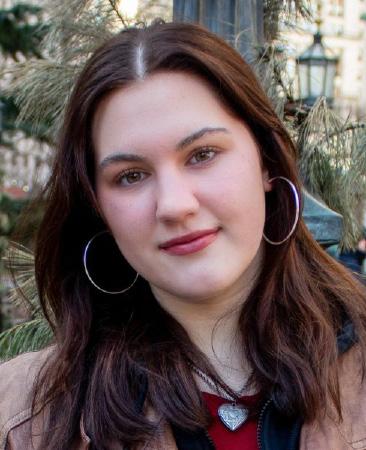
While trying to adapt to this new environment, she quickly realized the challenge of balancing it with a brand-new academic schedule. She described this difficulty: “The city, the academics and the rigorous schedule were just not as fun as I imagined.” This colossal life shift caused her to overthink and not live in the moment. As a senior, she now feels some regret that she did not allow herself to live in the moment more.
“Instead of embracing those hard moments and recognizing them as part of the experience, I just wanted to be in the future,” Whisler said.
Now, as a senior, Whisler can look back on her college experience and detail what helped her overcome those tough times and create the wonderful memories she holds today.
In recounting what made her college experience, she described her social journey. From meeting some of her best friends during her freshman year to joining a sorority during her junior year, she was able to get through some of her tough times with the people around her. When asked what she would advise incoming freshmen, she said that though you may not like everyone you meet, putting yourself out there is the most important part.
Pinpointing what parts of college made her who she is today, Whisler stated that her friendships made her grow. As she put it, “Everyone focuses on academics, but you really learn how to communicate and navigate relationships.”
Though college is filled with both bad and good experiences, she believes that those experiences and the people she met throughout the ride shaped her.
Duygu Kondakci
Duygu Kondakci will graduate with a double major in Psychology and Sociology/Anthropology in the spring. In our interview, she recounted moments in which she made the most of her opportunities. A Brooklyn native, Kondakci decided to live on campus her freshman year but has commuted since then. She considers the choice to transition into college life first through dorms deeply valuable. Having that foundation of friendships on campus allowed her to evolve from there.

As a commuter, she made it a priority to stay involved through extracurriculars and campus jobs. In her involvement with the Psychology Club, Psi Chi and her campus job, she said it was both a social and an academic choice. On the social end, Kondakci stated, “I think joining clubs and having campus jobs made me feel more involved—it kind of combatted that commuter-like isolation that some people feel.”
Through her academic and career involvement
with on-campus activties, she described being incredibly grateful to make connections that have followed her into her career expeditions. She would advise incoming freshmen to dive in in the same way.

When asked if she would have done anything differently, Kondakci said she would have regretted missing out on studying abroad. Although she hadn’t expected to study abroad initially, she realized it was a chance to gain a broader perspective beyond New York City.
Though she recounts her gradual growth from freshman to senior year, she stated that studying abroad gave her her favorite and most formative college memories. Moving into post-graduation, she simply couldn’t be more grateful that she took advantage of all the possible opportunities.
Savannah Ford
Lastly, senior Savannah Ford, an English major with a French minor, will graduate this year. She began college as a Health Sciences major, but halfway through her freshman year, she realized she didn’t want to continue down that path.

Influenced by external pressures, Ford chose the major despite her own uncertainties. While she struggled with this challenging academic transition, she felt overwhelmed. Traveling all the way from San Diego for college, she felt lost as she dealt with culture shock, academic uncertainty and the lack of a solid friend group, making her early college years especially difficult.
Now, looking back, she thinks of the struggle as a life lesson itself.
“It was really transformative, as cliché as that sounds, but it’s true—and I think that struggle helped shape who I am now,” Ford said.
Though dealing with the stress and the struggle in the present may not be easy, Ford feels that she wouldn’t be who she is today without it.
While finding her passions at college, Ford stated that the University’s extracurriculars helped her find herself. Though she wishes she had been able to find these communities sooner, Ford proudly told me that she felt like she belonged in her club communities. As the president of Aphros Literary Magazine and a member of both The Pace Press and the dance club, Ford advises incoming freshmen to explore their own community. She expressed that these clubs allow her to feel more grounded.
During our conversation about regrets, Ford said she felt happy to have those experiences rather than regret them. She wished she hadn’t stressed so much in the moment, saying, “You just have to ride out the uncertainty and trust that you’ll end up where you need to be eventually.”
Allowing uncertainty to dictate her growth, Ford is able to look back on her past mistakes without judgment or shame; instead, she knows they were all part of her learning process.
While Maddie Whisler, Duygu Kondakci and Savannah Ford had varying college experiences, all three students expressed strikingly similar lessons. Learning from hard moments, all three have chosen to embrace their struggles rather than ignore them. Though they’ve experienced significant personal growth in the past four years, all three understood this is only the beginning. All three students spoke about finding their community through various clubs and opportunities on campus. Whisler, in particular, emphasized that people we meet in college shape us just as much—if not more—than academics do. As these students reflect on the finish line of college, their lack of regret suggests that the best way to navigate this journey is by living in the moment and trusting the process. These seniors will graduate with not just a degree, but a list of stories and experiences that have prepared them to continue growing confidently.
FEB. 14, 2025
ALBERGO Columnist
Welcome back, Setters! While some of us are finishing out our last semesters, others are just getting started. Either way, we all have one thing in common: trying to find a good place to study. Since moving to campus, I’ve invested a lot of time into finding cheap and cozy study spots nearby. Since this is my last semester at the university (so crazy), I’ve decided there’s no point in gatekeeping them anymore. With that said, here are some of my favorite study spots in FiDi:
1. Conwell Coffee Hall: 6 Hanover St, New York, NY 10005
This café is my favorite study spot near campus. Located in the 20 Exchange Place-CIBC building, the former bank-turned-elegant coffee lounge is the perfect place to relax while getting work done. The comforting atmosphere, soothing jazz music and delectable brunch menu will make you want to study for hours. My roommate and I love to come here and sip on iced almond milk matcha lattes while getting a head start on our week.

2. Mcnally Jackson Books Seaport: 4 Fulton St, New York, NY 10038

I’ve always found that I study better when surrounded by books. If you’re the same way, this might need to be your new study spot. Built in 1811, McNally Jackson is a cozy bookstore in the Schermerhorn Row building. It is right next to the East River, with amazing views of the Brooklyn Bridge and skyline, perfect for a little post-study city walk.
3. Brookfield Place: 230 Vesey St, New York, NY 10281

If you haven’t discovered this shopping mall yet, you need to. Located in the Battery Park City Neighborhood, this stunningly designed center is packed with cozy booths and tables throughout. While it is a little bit farther from campus (about a 15 to 20-minute walk), it is connected to the Fulton Center and Oculus, making it a much warmer walk if you start from inside and work your way over.
4. Remi Flower & Coffee: 130 William St, New York, NY 10038

Freshly opened, this new and unique coffee shop is great for lovers of nature, greenery and all things floral. Alongside its delicious coffee, matcha and pastries, the space is filled with vibrant flowers and plants, creating a refreshing atmosphere for students. The shop also sells beautifully arranged floral bouquets, making it a perfect spot to grab a coffee and a little something special.
Whether you’re tackling an essay, cramming for an exam or just looking for a cozy spot to unwind with a book, these places have never let me down. I hope you get a chance to check them out and maybe even find your new favorite study spot. Happy studying!
SABRINA CROWLEY
Assistant
News Editor
March is Women’s History Month, and while there are so many women who have made contributions to a variety of industries, these are some of the most influential women in music, STEM, sports and literature, whom everyone can celebrate this month.
Music: Dolly Parton
Releasing music since 1959, Dolly Parton is one of the most influential musicians of her time. Her songs have been on the Billboard Hot Country Songs chart for seven decades, and she has had more number-one hits than any other female artist in history. Parton has also won 10 Grammy Awards and written over 3,000 songs.
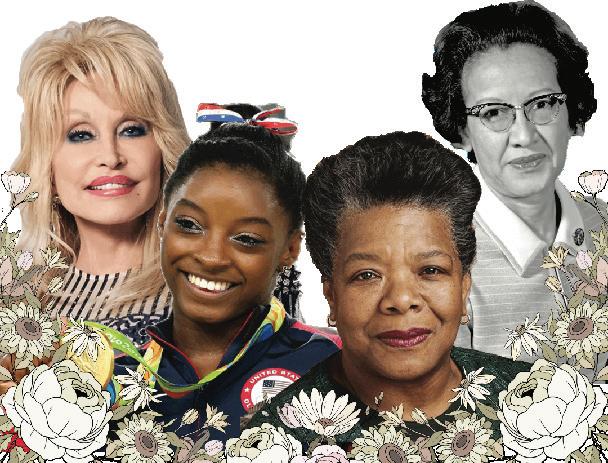
Parton was one of 12 children who grew up in the Great Smoky Mountains, Tennessee. Although poor, she started her music career by playing for the church. She eventually signed with a small record label; the rest is history.
Today, Parton is not only a musician but also a businesswoman and philanthropist. She owns the Dollywood theme park, which employs 11,000 workers–all of whom are eligible for Parton’s education plan, Grow U. This plan pays 100% of tuition for employees who want to pursue a college degree. In 1988, Parton also established the Dollywood Foundation, whose mission is to decrease Tennessee’s high school dropout rates and gift books to 1 million children a month worldwide.
“I know there are children in your community with their own dreams. They dream of becoming a doctor or an inventor or a minister…The seeds of these dreams are often found in books and the seeds you help plant in your community can grow across the world,” Parton said.
Dolly Parton is more than just a musician. She is an example of a woman who has used her success for good worldwide.
STEM: Katherine Johnson
Katherine Johnson was born in Virginia in 1918. She began attending high school at age 10 and graduated from West Virginia University with bachelor’s degrees in mathematics and French at age 18.
In 1953, Johnson began working at the National Advisory Committee for Aeronautics (now known as NASA) in the West Area Computing unit. This unit comprised African American women who manually performed complex calculations for the program’s engineers. The women’s work was essential to the success of the early U.S. space program.
Johnson played an important role in several programs, including Freedom 7, which sent the first astronaut into space and Apollo 11, which landed on the moon. She later worked on the Space Shuttle program and retired from NASA in 1986.
Johnson received numerous honors for her work, including the Presidential Medal of Freedom. In 2016, NASA named a building after her, the Katherine G. Johnson Computational Research Facility. A book and movie about the West Area Computing unit were created titled “Hidden Figures: The American Dream and the Untold Story of the Black Women Mathematicians Who Helped Win the Space Race.”
Johnson contributed so much to NASA, especially as a Black woman in the 20th century. Her hard work and perseverance are admirable and motivational. Johnson passed away in February of 2020, but her memory will live on forever.
Simone Arianne Biles Owens– better known as Simone Biles–was born on March 14, 1997. At 27 years old, Biles is the most decorated gymnast in the world, with 11 Olympic medals and 30 World Championship medals. Biles is the first gymnast to rank among the world’s highest-paid female athletes in at least a dozen years, and in July 2022, she received the Presidential Medal of Freedom.
Biles started gymnastics in 2003; in 2012, she switched to homeschooling to spend more hours per week to train for gymnastics. She had planned to attend the University of California, Los Angeles for college, but instead went professional before the Summer Olympics in 2016.
In 2013, at the age of 16, Biles became the seventh American woman and the first African American to win the World all-around title. In the 2016 Summer Olympics, she won gold in both the team and individual events and set an American record for the most gold medals in women’s gymnastics at a single Olympic Games–all at the age of 19.
As Biles has publicly mentioned, it has taken her a lot–physically and emotionally–to get to where she is today. Biles has talked about the hardship she experienced, the abuse she has gone through and the pressure she has felt. Her bravery and love for her sport is why she continues to do what she does.
“Always work hard and have fun in what you do because I think that’s when you’re more successful. You have to choose to do it,” Biles said.
Literature: Maya Angelou
Maya Angelou, born April 4, 1928, in St. Louis, Missouri, was a writer, editor, essayist, playwright and poet. Aside from her writing, Angelou worked closely with Dr. Martin Luther King Jr. and Malcolm X, as well as as an educator at Wake Forest University.
Angelou faced many hardships throughout her life. In her most famous work, “I Know Why the Caged Bird Sings,” Angelou described how her mother’s boyfriend raped her when she was only seven years old. Her uncles murdered the man for his crime, and Angelou felt responsible; she went mute for five years but developed a love of language along the way.
Angelou went on to work in civil rights for many years and wrote countless works while also being a mother and grandmother. She served on two presidential committees: Gerald Ford’s in 1975 and Jimmy Carter’s in 1977. In 2000, President Bill Clinton awarded Angelou the National Medal of Arts; in 2010, President Barack Obama awarded her the Presidential Medal of Freedom.
Angelou was awarded over 50 honorary degrees before her death in 2014 at the age of 86. Despite the trauma she faced in her life, she continued to be a strong and inspirational woman whose literary work will last for centuries.
FEB 8, 2025
SHEILA RAFIZADEH
Assistant Op/Ed Editor
We often go about our daily lives not thinking much about how the Supreme Court shapes the world around us. From the rights we exercise to the laws that govern us, the Court’s rulings impact nearly every aspect of American society. Whether it’s determining what the government can or can’t do or deciding the limits of our freedoms, its decisions echo through history and flow into our everyday experiences. If there were ever a Supreme Court case to wear the “landmark” crown, Marbury v. Madison would be it. This 1803 decision didn’t just shake up the judiciary–it practically built it. Without it, the Supreme Court might have remained the least threatening branch of government, overshadowed by Congress’ purse strings and the executive branch’s military might. Instead, thanks to Chief Justice John Marshall, the Court went from “just some guys in robes” to the ultimate constitutional referee.
To understand Marbury, you first need to understand the unfiltered political drama of early America. At the time, the nation had two major political parties: the Federalists and the Democratic-Republicans. Let’s just say they hated each other (think Hamilton-Burr levels of tension but with fewer duels). Federalist President John Adams, having just lost his reelection to his own Vice President-turned-political opponent, Thomas Jefferson, decided to throw a last-minute wrench into Jefferson’s plans. In what history now calls the Midnight Appointments, Adams and his Federalist-controlled Congress created a ton of new judicial positions and stacked them with Federalists before
Jefferson could take office. Adams was signing judicial commissions practically until he walked out of the White House. Some were delivered, but others—like the one for William Marbury, who had been appointed Justice of the Peace—were left sitting on a desk when Jefferson took over. Jefferson, being no fan of Adams, ordered his Secretary of State, James Madison, to leave those commissions undelivered.
Enter William Marbury, a man who wanted his job. Marbury, frustrated that his judgeship had been lost in the presidential transition shuffle, sued Madison. He asked the Supreme Court to issue a writ of mandamus–a legal order forcing a government official to do their job—in this case, to deliver Marbury’s commission. Sounds simple enough, but there’s much more to the story. The case wasn’t just about a single piece of paperwork; it raised a much bigger question: Did the Supreme Court even have the power to force Madison to deliver the commission in the first place?
Before reaching a decision, the Supreme Court considered three critical questions: Did Marbury have a right to his commission? If he had a right, and that right was violated, did the law provide a remedy? If a remedy was available, was the Supreme Court the correct body to issue it? Marshall answered the first two questions with a resounding yes—Marbury had been legally appointed, and when a right is violated, the law must provide a remedy. However, the third question led to the case’s groundbreaking conclusion. Now, here’s where things get interesting. The Chief Justice overseeing this case was none other than John Marshall—who, funnily enough, had been Adams’ Secretary of State. That’s right, the same guy who was
supposed to deliver Marbury’s commission was now ruling on whether it had to be delivered. Talk about a conflict of interest!
Marshall and his fellow justices faced a puzzling dilemma. If they ruled in favor of Marbury and ordered Madison to deliver the commission, Jefferson’s administration could just ignore the ruling, making the Court look weak. But if they ruled against Marbury, they’d concede that the judiciary had little authority. Instead, Marshall took a third option, and this option changed American law forever. Marshall ruled that while Marbury did have a right to his commission, the Court couldn’t issue a writ of mandamus because the law that gave the Court that power—the Judiciary Act of 1789—was unconstitutional. And just like that, the Supreme Court established judicial review, the power to strike down laws that violate the Constitution. With this ruling, the Court positioned itself as the ultimate interpreter of the Constitution, capable of keeping Congress and the President in check.
To this day, Marbury v. Madison remains one of the most important cases in U.S. history. Every time the Supreme Court strikes a law as unconstitutional, you can thank John Marshall for making it possible. So next time someone tells you the Supreme Court doesn’t have much power, just remind them: they’ve been overruling presidents and Congress since 1803. It all started with a forgotten commission, a political grudge and a Chief Justice who saw potential in the little things.
MARCH 10, 2025
AVA SCOTT Columnist
In light of last week’s Oscar ceremony, I decided there was no better time to talk about the big winner of the night–Sean Baker’s “Anora.” Directed, produced, edited and written by Baker, the film made him the biggest winner at the 97th Academy Awards, taking home the trophies for Best Director, Best Editing, Best Screenplay and Best Picture.
The heart of this film is, without a doubt, Mikey Madison. Madison stars in her first leading role in a film as the project’s titular character, a sex worker in Brooklyn who gets her shot at her very own Cinderella story–but ends up caught in a web of confusion and underground politics that she never could have anticipated. Madison earned the Academy Award for Best Lead Actress for the performance, which challenged her in many ways, from acting in intensely intimate and vulnerable scenes to perfecting a born-and-bred Brooklyn accent.
When I first watched “Anora,” it had already been out for a few months. I didn’t do that on purpose; it was just one of those films I never had time to see in theaters. The months of purgatory between the silver screen and an accessible streaming service seemed to stretch on and on. I immediately recognized it as a wholly unique storytelling experience, and I found myself moved by Madison’s performance at several points throughout the film.
Anora is a character you can root for. She often voices the audience’s thoughts, reacting to the increasingly insane situations she gets wrapped up in with a charming–even if a little foul-mouthed–candor. Madison’s performance is due in equal measure to Baker’s writing, and while “A Real Pain” is still my favorite screenplay of 2024, I was still happy to see Baker receive critical acclaim for his role in bringing Anora to life.
One of my favorite details about this film is how carefully Baker considered the weight of names while writing the script. Although Anora is the film’s title, our heroine seldom uses that name. She often goes by Ani, but we see through her interactions with her sister that those close to her call her by her full name. The reverse can be found in Vanya—or, as his parents call him, Ivan.
The people close to each of the characters in the relationship at the film’s center never know one another well enough to start using their full, more intimate names. Anora always calls Ivan “Vanya,” and Ivan always calls Anora “Ani.” It’s a fascinating detail that I couldn’t articulate after my first watch, but upon this rewatch, I felt it much more presently–especially during the conversation where Igor specifically says Anora is “a beautiful name,” symbolizing his more genuine nature.
All in all, “Anora” deserves all the critical acclaim and accolades it has achieved. Even though it was nominated alongside some tough competition, the fact that it prevailed over some other favorites of 2024 (cough, Demi Moore, cough) does not mean that it was any less deserving of these accolades. It was a big night for a film with a small budget and production team—at least compared to other films also nominated—and featured one of the greatest rising stars of the year.
Rating: 5/5
APRIL 2, 2025
SHEILA RAFIZADEH Assistant Op/Ed Editor
Women have historically been underrepresented in STEM (science, technology, engineering and mathematics) fields and university programs. It is more important than ever to empower girls and give them equal opportunity in all professions, particularly STEM, in today’s ever-changing world. However, obstacles, including social prejudices, a lack of confidence and exposure to strong role models, prevent girls from pursuing jobs in these crucial fields. At the University, several women have embraced these challenges head-on, driven by passion and a vision for the future.
For University senior and Psychology major Nikki Sabet, a deep fascination with biology and psychology led her down the pre-medical track. However, her journey has not been without obstacles. “I’ve often felt discouraged and overlooked,” she admits. “There are times when I feel like I am behind and not experienced enough compared to others in my field. But I continue to work hard and push through it no matter what obstacles I face or doubts I have.”
According to research, girls start to question their aptitude for STEM disciplines as early as age 6. Social messages and the dearth of strong female role models in the industry are frequently to blame for this lack of confidence. Mia Ortiz, a university freshman majoring in Cybersecurity, echoes this sentiment: “I’ve had some really rough work situations and interviews that opened my eyes about being a female in IT.” she explained further, “Having to know more and work twice as hard is part of the game, which is fine because I’ve accepted that’s how it works in a male-dominated field. But I keep working hard and trying my best to one day be a role model for other women in the field.”
Despite the challenges, she is hopeful about the future. “My optimism that the IT business is changing to be more inclusive grows as I connect with more female IT professionals. Being a voice in my tiny circle to raise awareness of the challenges women encounter is part of that.”
Many find that the lack of female mentorship in STEM-related fields is due to the historical erasure of women’s contributions to science and innovation throughout the years. Science historian Margaret Rossiter first spoke about this phenomenon when she coined the term “Matilda Effect.” Mia Barto, a freshman at the University, finds that this speaks to her experiences navigating the complex field of chemistry.
Barto’s drive to excel in a male-dominated field stems from both passion and determination. “I chose to pursue a career in the sciences not only because I have always had a passion for math and chemistry, but also because I believe that it is powerful to be the ‘best’ in a male-dominated field as a woman,” she says. “Being the best at what I do has always been the goal.”
Barto is particularly aware of the historical erasure of women’s contributions to science. “Many times, men who received recognition worked with women behind the scenes who were given no credit. This has instilled a fear in me of being taken advantage of in the future, of working on a project only to have my research or ideas stolen. But I plan to fight for my credit because I would never let the fact that this field is male-dominated take away the impact that I plan to have.”
Her advice? “Always fight for your credit. Be confident in your ideas and knowledge. Let it be known that you are the future scientist with these abilities—never hold back.”
Women have historically been underrepresented in STEM (science, technology, engineering and mathematics) fields and university programs. It is more important than ever to empower girls and give them equal opportunity in all professions, particularly STEM, in today’s ever-changing world. However, obstacles, including social prejudices, a lack of confidence and exposure to strong role models, prevent girls from pursuing jobs in these crucial fields. At the University, several women have embraced these challenges head-on, driven by passion and a vision for the future.
For University senior and Psychology major Nikki Sabet, a deep fascination with biology and psychology led her down the pre-medical track. However, her journey has not been without obstacles. “I’ve often felt discouraged
and overlooked,” she admits. “There are times when I feel like I am behind and not experienced enough compared to others in my field. But I continue to work hard and push through it no matter what obstacles I face or doubts I have.”
According to research, girls start to question their aptitude for STEM disciplines as early as age 6. Social messages and the dearth of strong female role models in the industry are frequently to blame for this lack of confidence. Mia Ortiz, a university freshman majoring in Cybersecurity, echoes this sentiment: “I’ve had some really rough work situations and interviews that opened my eyes about being a female in IT.” she explained further, “Having to know more and work twice as hard is part of the game, which is fine because I’ve accepted that’s how it works in a male-dominated field. But I keep working hard and trying my best to one day be a role model for other women in the field.”
Despite the challenges, she is hopeful about the future. “My optimism that the IT business is changing to be more inclusive grows as I connect with more female IT professionals. Being a voice in my tiny circle to raise awareness of the challenges women encounter is part of that.”
Many find that the lack of female mentorship in STEM-related fields is due to the historical erasure of women’s contributions to science and innovation throughout the years. Science historian Margaret Rossiter first spoke about this phenomenon when she coined the term “Matilda Effect.” Mia Barto, a freshman at the University, finds that this speaks to her experiences navigating the complex field of chemistry.
Barto’s drive to excel in a male-dominated field stems from both passion and determination. “I chose to pursue a career in the sciences not only because I have always had a passion for math and chemistry, but also because I believe that it is powerful to be the ‘best’ in a male-dominated field as a woman,” she says. “Being the best at what I do has always been the goal.”
Barto is particularly aware of the historical erasure of women’s contributions to science. “Many times, men who received recognition worked with women behind the scenes who were given no credit. This has instilled a fear in me of being taken advantage of in the future, of working on a project only to have my research or ideas stolen. But I plan to fight for my credit because I would never let the fact that this field is male-dominated take away the impact that I plan to have.”
Her advice? “Always fight for your credit. Be confident in your ideas and knowledge. Let it be known that you are the future scientist with these abilities—never hold back.”
In the era of modern medicine, science and technology, it is crucial that female STEM students uplift one another. Due to erasure, there may not be many historical female figures to look up to, but that just opens the door for the current generation to step up and be those role models. Aspiring microbiologist and university senior Aditi Bhatt relays the importance of mentorship by advising future students to “Be confident in your abilities, speak up and find mentors who believe in you.” She continues, “I try to surround myself with supportive colleagues who uplift each other and break down barriers.” Bhatt remains steadfast in her ambitions and will receive her Bachelor of Science in Biochemistry this May.
Success in STEM requires confidence, perseverance and a willingness to stand up for oneself. While challenges persist, they continue to forge ahead, paving the way for future generations. The goal is clear: be confident, push forward and never underestimate your own abilities. At the University and beyond, the future of STEM is increasingly female—and these young women are proving just how powerful that future can be.
LYDIA LUTCHMAN Treasurer
Ashleigh Andersen, Licensed Clinical Social Worker (LCSW,) is the Interpersonal Violence Prevention and Education Specialist at the University’s Office of Sexual and Interpersonal Wellness (OSIW). Located in room 908 at 41 Park Row, the office provides support and resources for students who are or have been impacted by sexual violence or intimate partner violence by offering violence prevention initiatives, training and events. Andersen is a confidential resource on campus, meaning she is not a mandated reporter, while the peer educators of that office are private resources and report only to her.
What inspired you to pursue a career as a LCSW?
I always knew that I wanted a career that helped people in some way, but my understanding of what that could look like when entering college was limited. I went to college as a political science major, thinking I was going to be a civil rights attorney, but as I took more of my major classes, I realized that was not quite the right fit for me. My limited understanding of social work at the time was through things like the Administration for Children’s Services (ACS) and a lot of negative depictions on television. It was not until my first job out of college as a case manager that I gained a fuller understanding of what a social worker was and just how much I could do. I could be a therapist, advocate, or work in a school, or a hospital or a legal setting, etc. The options are pretty endless. After a couple of years in that role, I applied to grad school to get my master’s in social work, and it was the best decision I could have made.
What drew you to working in the field of sexual and interpersonal wellness specifically?
I have always had an interest in gender-based violence prevention from both personal and professional perspectives. That first job I had out of college as a case manager was at a domestic violence (DV) shelter, and it really solidified my passion and commitment to this work. My experiences following that with grad school, internships, and future jobs broadened my understanding of the need for healthy relationship education, the gap in services for marginalized people, and how direct intervention (therapeutic services) with individuals and prevention through education was critical to moving towards ending gender-based violence.
Do you have a typical morning schedule, or does everyday look different?
Every day looks a little different depending on [whether] I have meetings, events, student sessions or workshops. I try not to schedule anything for the first or last hour of the day so I have time to prepare for the day ahead and the one following. It does not always work out, but most of the time, I am able to do that.
How do you prepare for the day ahead? Are there any routines or check-ins you prioritize?
I have a running list on my computer of tasks I need to complete and flag any emails that I need to prioritize. I will set aside time throughout my day/week to make sure I stay on top of anything time-sensitive.
How do you create a welcoming and supportive space for students who may be hesitant to seek help?
I try to create a space where students can feel comfortable sharing their stories—a space where they are heard and their experiences are validated. It can be scary or intimidating coming to an office like mine because maybe you are not fully sure why you are here or what to expect, but know that this is a safe, confidential, and judge-free space to receive support, information and resources. If I am not in the right place for whatever reason, I will make sure to connect you to a resource that is.
MARCH 22, 2025
What kinds of student concerns do you typically address in a day? Can you walk me through a typical one-on-one session or student interaction? Every student’s concerns and sessions are different. It can be anything from past relationships or sexual trauma to something that has happened more recently, to questions about sex/gender identity/sexual orientation, to making sense of an experience that just did not feel right. Often, students come for one reason, and many times, it connects to other things, and we spend time processing and making sense of how it all works together. The student is the one in charge of how much they want to disclose and how often we meet, so it is mostly up to them what they would like to get out of a session.
How do you balance meetings with students, outreach and administrative tasks throughout the day?
From a logistical standpoint, my calendar is my best friend. It keeps me organized and on top of everything I need to do, so I am better able to plan my time. From a personal standpoint, balancing all of these different tasks helps me not feel burnt out in any one area because my day-to-day is always different.
What role do peer educators play in your daily work?
Peer educators are wonderful resources that help me with outreach, planning and hosting events, and connecting with students one-on-one who may not be ready to meet with me or would prefer a peer interaction to receive information on resources and services available to them.
What is the most challenging part of your day?
I am not sure there is a challenging part of my day other than sometimes it feels like there just are not enough hours in it. Looking more broadly, I think my greatest challenge in this role and running this office is getting students to know about who I am and [the] services they have access to.
What is the most rewarding part?
The most rewarding part for me is meeting with students for one-on-one sessions and having really engaging conversations in workshops I facilitate. I think, in both circumstances, I am able to see the work being done in real-time.
Is there a particular moment in your day when you feel like you are truly making an impact?
The moments when I can see students making connections or a lightbulb going off in their head from a conversation, a session or a workshop makes me feel like I am truly making an impact.
How do you wind down at the end of a workday?
At the end of the workday, I wrap up any emails or tasks I could not complete earlier. Once it is 5 p.m., I usually head to the gym, go home to make dinner and then binge-watch whatever show my partner and I are watching at the time!
Do you take time to reflect on the day’s conversations and experiences?
Absolutely! Some days are harder than others, but even with the hard ones, I know that a student is on the path to healing if they [take] that first or second or third step to meet with me, and that helps shift my 1perspective in a more positive way.
Given the emotional nature of your job, how
do you separate work from personal life?
I have been in this field for about 11 years, and it took me a while to figure out a healthy work/life balance. Now I know to have healthy boundaries with work, like only working within my designated hours, not answering emails outside of that time (for the most part), going to my own therapy, having my community of people and doing things that bring me joy outside of work.
What is one change you wish campuses would make to better support student wellness?
One change I wish campuses would make would be to have mandatory healthy relationship education for all students, with it continuing from freshman year to senior year. For many students, they do not receive any information on what a healthy relationship is, understanding consent or how to set boundaries, and I think this is critical for everyone to build healthy interpersonal relationships throughout their lives.
What keeps you motivated to do this work day after day? Working in this field can be emotionally demanding. How do you take care of yourself and prevent burnout?
What keeps me motivated is that this work is important and necessary. Having a healthy work-life balance helps to prevent burnout, and also, getting to see the real-life impact of this work makes me want to do this in some capacity forever.
If you could change one thing about how campuses approach sexual and interpersonal wellness, what would it be?
I think the change I would make would be to put more of an emphasis on its importance. For the most part, currently, it exists for students who are personally impacted or have an interest in the content, but we are all impacted by sexual and interpersonal wellness-related issues in one way or another. Learning to build healthy relationships and how to build community is so fundamental to our well-being and our humanity that it should be information and education that is woven into every aspect of the college experience.
What advice would you give to students who are interested in pursuing a career in social work or wellness education?
The best advice I would give is to find social workers to talk to (like me!) so you can ask indepth questions and do an intern

MAI CLIFFORD
Opinions and Editorials Editor
On Monday, Jan 20, Donald Trump was sworn in as the 47th President of the United States. The inauguration, held in the United States Capitol, drew audiences worldwide as supporters tuned in to listen to his promises of a better nation, and critics braced for the consequences his divisive rhetoric will have on the country. Shortly after taking the oath of office, Trump delivered his 29-minute inaugural address, designed to inspire unity and prosperity. However, beneath these themes of American empowerment lay a speech dripping with hypocrisy, fear-mongering and a troubling glimpse into the next four years ahead.
As Trump stood at the podium, stating his unwavering support of “everyday Americans,” a front row of billionaires gleefully cheered him on. This glaring hypocrisy of double standards fueled his rise to power, a self-described “outsider” who leverages the very elitist power structures that he pretends to dismantle.
From the beginning of his address, Trump painted a rather dreary portrait of the nation, declaring that “American carnage” was ravaging the nation. He illustrated a country filled with struggling families, factories closing and crime running rampant, conveniently ignoring the facts: violent crime is at historic lows, the economy is booming and inflation rates are only decreasing. This incredibly dystopian and simply inaccurate representation felt beyond exaggerated and entirely unpresidential. His framing of the country was designed to evoke fear. Rather than highlighting American success, he chose to depict the country as being on the edge of ruin and positioned himself as the one person who would be able to fix it. By portraying himself as the sole savior of what he deems a failing nation, Trump directly undermines the democratic principles this country was established on.
One of the executive orders Trump discussed in his address was that he would be immediately implementing “a national emergency at our southern border” where “all illegal entry will immediately be halted, and we will begin the process of returning millions and millions of criminal aliens back to the places from which they came.” This kind of rhetoric and dehumanizing language was a calculated tactic to appeal to the xenophobia Trump himself has fueled in this country. His obsession with using immigrants as a scapegoat is not a simple dividing technique; it is an attempt to distract citizens from the real systematic issues with the United States immigration procedures that he has absolutely
ZORA POR-REINHARDT
JAN. 22, 2025
no intention of addressing or solving.
Another theme Trump emphasized in his address was the supposed transfer of power from political elites to the American people, stating, “We are transferring power to you, the people.” This sentiment was met with a round of applause from the audience. However, when juxtaposed with the reality of his administration, it is evident that it is yet another hollow promise. He has appointed one of the wealthiest cabinets in United States history, with corporate executives and 13 billionaires occupying key roles. It begs the question: How can a government that is led by hedge fund managers and oil tycoons claim to understand the reality and struggles of everyday Americans?
The speech’s focal point was his “America First” mantra, which was as isolationist as it was equally short-sighted. Trump promised to put American interests above all else, especially regarding trade and foreign policy. Trump claimed he would overhaul the trade systems and alleged, without presenting any evidence, that “there will be massive amounts of money pouring into our treasury, coming from foreign sources.” This transactional nature and approach could very well isolate and alienate allies, disrupt international partnerships and undermine the United States’ standing on the global stage. His comments about renaming the Gulf of Mexico to the “Gulf of America” and “taking back” the Panama Canal were not just outrageous but dangerous and underscore an incredi bly worrying nationalistic and somewhat imperial istic nature of Trump’s goals. It raises an alarming question: How does Trump plan on being “respected all over the world again” by turning his back on the very nations we depend on for trade and diplomacy?
Potentially most troubling was Trump’s complete departure and rejection of climate initiatives. He proudly announced in his speech that his administration would immediately withdraw the United States from the Green New Deal, calling it a “job-killing disaster,” completely dismissing initiatives to reduce carbon emissions and scientific proof of climate change. With his comments and framing of environmental action as a threat to economic growth, Trump completely ignored the long-term environmental and financial costs of not acting on climate change now. These remarks set a worrying tone for the next four years, suggesting an administration willing to turn away from sustainability and global efforts to address and resolve the climate and environmental crisis.
All the aforementioned decisions have come only one day into his presidency. From completely dismantling years of environmental efforts to repeatedly inciting fear and fueling division, undermining democratic principles and completely alienating our allies, his actions within the first 24 hours of his presidency have already set a troubling precedent. With 208 weeks ahead, Americans must come to terms with the incredibly jarring reality of the road ahead and what the future of this nation will look like if this is how his administration begins. This address was not meant to unify the country but to warn it. It was a glimpse into the hypocrisy and unchecked power that will dictate
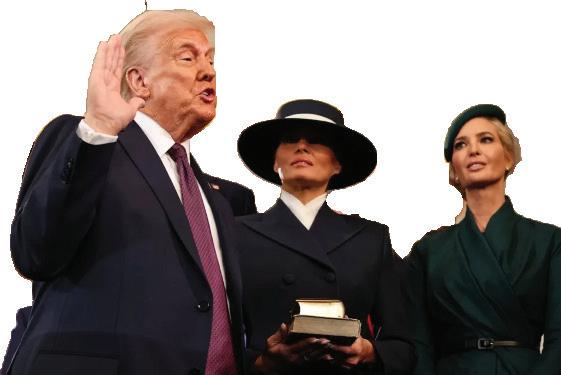
FEB. 21, 2025
Contributor Since reassuming office in January, Trump has signed over 60 executive orders aimed at restructuring the government and redefining the United State’s role on the global stage. His aggressive foreign policy, crackdown on illegal immigration and push to dismantle federal agencies have raised serious concerns, reflecting an administration that appears to disregard the Constitution and the balance of powers.
During his first term, Trump secured a conservative majority in the Supreme Court by appointing Justices Amy Coney Barret, Brett Kavanaugh and Neil Gorsuch. Simultaneously, conservative ideology has become increasingly dominant throughout the Senate, House and Congress. As the nation’s most important political systems lean more conservative, Trump’s power may go unchecked, creating uncertainty for the future of American democracy. With key branches of government aligned with his agenda, the question remains: what will become of the checks and balances meant to preserve democratic integrity?
The federal courts may be the last defense in maintaining the democratic balance of power.
Federal judges have already challenged some of Trump’s executive orders, questioning their constitutionality. As Trump attempts to target undocumented immigration through every sphere, he sought to enact legislation that would end birthright citizenship for children of undocumented parents, arguing that the Fourteenth Amendment has never applied to them, as they are not “subject to the jurisdiction of” the United States. In response, U.S. District Judge Leo Sorokin became the fourth judge to issue a preliminary injunction to temporarily block the order, citing that the Constitution broadly applies and guarantees birthright citizenship. Judge Sorokin’s ruling emphasized the Trump administration’s executive overreach and its violation of the Citizenship Clause of the 14th Amendment.
Judge Sorokin further noted that the executive order imitates historical injustices, such as the Dred Scott v. Sandford decision, where the Supreme Court issued a ruling excluding and denying constitutional protections to enslaved people. Simi-
larly, Trump’s order targets children of undocumented parents, perpetuating discriminatory rhetoric and attempting to strip them of their constitutional rights. The judge’s swift response sent a clear warning to Trump and his administration.
Other politicians have publicly criticized his actions and supported the judge’s sanctions. Massachusetts Attorney General Andrea Campbell stated, “President Trump may believe that he is above the law, but today’s preliminary injunction sends a clear message: He is not a king, and he cannot rewrite the Constitution with the stroke of a pen.” The early days of Trump’s second term signal that tensions between the executive and judicial branches will likely remain consistent throughout the next four years.
Another legal challenge emerged when Rhode Island’s federal judge, John J. McConnell Jr., ruled that the Trump administration defied his order to release billions of dollars in federal grants and loans. In response, Harrison Fields, the White House spokesperson, dismissed the ruling as “an attempt to undermine the will of the American people,” insisting that “each executive order will hold up in court because every action of the Trump-Vance administration is completely lawful.” This rhetoric signals a troubling disregard for judicial authority, setting a dangerous precedent where this administration views constitutional limitations as an attack on executive power. Trump’s disregard for judicial authority and his administration’s unwavering loyalty is a dangerous combination that risks the stability of America’s democracy.
Amid troubling executive actions and attempts at reframing the Constitution to fit a regressive agenda, upholding the system of checks and balances is more important than ever. The ongoing struggle between the executive and judicial branches reflects a broader threat to American democracy, where constitutional integrity, transparency and accountability are at stake. As the Trump administration continues to push the boundaries of presidential power, the federal courts may serve as the final defense for the rule of law and constitutional protections. If Trump’s power remains unchecked, the consequences for American democracy could be irreversible. Its survival relies on the resilience of the nation’s political institutions to restore the balance of power, ensure the country’s stability and protect its freedoms.
MARCH 9, 2025
NICHOLAS
COVONE Columnist
With the 2025 Major League Baseball (MLB) season quickly approaching, it is time to reflect on this past offseason and highlight the biggest winners and losers. There have been many blockbuster trades and free-agent signings that will impact this upcoming MLB season, and seasons for years to come. While some teams made significant improvements to their rosters, others missed their opportunity to do the same. First, let’s break down the winners of this offseason.
Winners:
Boston Red Sox
Key Additions: Alex Bregman. Garrett Crochet, Walker Buehler
The Boston Red Sox made many noteworthy moves this offseason to bolster their lineup and pitching rotation. The addition of Alex Bregman gives them a star veteran with lots of postseason scar tissue, along with versatility in the infield. Garrett Crochet emerges as the ace the Red Sox desperately needed, and Walker Buehler offers a high upside with minimal risk. After missing the postseason by just five games last year, these additions give Boston the potential to contend not only for the American League (AL) East division title but also for the AL Pennant.
New York Mets
Key Additions: Juan Soto, Clay Holmes, A.J. Minter
Re-signed: Pete Alonso, Sean Manaea, Jesse Winker
The New York Mets took a big swing this offseason, signing all-star right fielder Juan Soto to a 15-year, $765 million contract. Being the player on the market this offseason, Soto will have a huge impact on the Mets lineup. Along with Soto, the additions of Clay Holmes and A.J. Minter strengthened their rotation and bullpen. The Mets also re-signed Pete Alonso, Sean Manaea and Jesse Winker, all who had a huge impact on their 2024 postseason run. The Mets are in line for a big season, entering with the fourth-best odds to win the World Series.
Los Angeles Dodgers
Key Additions: Blake Snell, Rōki Sasaki, Tanner Scott, Kirby Yates
Re-signed: Teoscar Hernández, Blake Treinen
The reigning World Series Champions did not slow down during this offseason, signing several of the top players on the market. The Dodgers solidified their pitching rotation as one of the best in the league with the additions of two-time Cy Young winner Blake Snell and Japanese superstar Rōki Sasaki. They also now boast one of the best bullpens in baseball, adding top closer Tanner Scott and veteran Kirby Yates, while re-signing setup man Blake Treinen. The Dodgers will have nearly the same lineup as last season after re-signing All-Star Teoscar Hernández. Remarkably, this superteam managed to get even better this offseason, and a shot at back-to-back World Series titles is within reach.
Now moving on to the losers of this offseason.
Losers:
Seattle Mariners
Key Additions: Donovan Solano
Key Subtractions: Justin Turner
After narrowly missing the postseason by one game last season, the Mariners had a great opportunity going into this offseason to strengthen their offense to pair with one of the best pitching staffs in the league. However, Seattle failed to capitalize, with their most notable move being the signing of 37-year-old Donovan Solano. They spent just $11.25 million on free agents this offseason, while the rest of their division made significant improvements. Every other team in the division spent at least $60 million. Their offseason was so underwhelming that even former Mariner Justin Turner publicly questioned the team’s direction, asking, “What the hell are we doing? Are you trying?”
Atlanta Braves
Key Additions: Jurickson Profar
Key Subtractions: Max Fried, A.J. Minter, Charlie Morton
The Braves seemed to sleepwalk through the offseason, missing out on nearly every major free agent. While the addition of Jurickson Profar is a positive, last season was the only time in his career he posted an On-Base Plus Slugging (OPS) above .800. Their pitching rotation remains solid, however, they took big hits losing Max Fried and Charlie Morton, who they did not seem to replace. Similarly, with their bullpen, the bullpen took a hit with the departure of A.J. Minter, especially to a division rival. The Braves have a great roster and many key players returning from injury this season, but they should have done more to improve in the highly competitive National League (NL) East division.
San Diego Padres
Key Additions: Jason Heyward, Connor Joe, Nick Pivetta
Key Subtractions: Jurickson Profar, Kyle Higashioka, Ha-Seong Kim, Tanner Scott
The San Diego Padres had a nightmare offseason, losing four key players from last year’s postseason run without seeming to have a chance to re-sign any of them. Their biggest losses were Jurickson Profar, who was a great bat for them in the 2024 season, and Tanner Scott, one of the league’s top closers, who was signed by division rivals, the Los Angeles Dodgers. The Padres pushed the Dodgers to five games in the National League Division Series (NLDS) last postseason, coming very close to defeating them, only to fall apart in the end, which seemed to carry into the offseason. While their division rivals, the Dodgers and Arizona Diamondbacks, both got much better this offseason. The Padres will be lucky to place third in the NL West division this season.
MLB Opening Day is Thursday, March 27, these moves in the offseason should make for another exciting baseball season.
The price of
MARCH 4, 2025
MILANA POGRETSKAIA Features Editor
In a world so focused on careers and ambitions, the competitive job market has made it almost impossible to think about anything other than the relentless pursuit of achievement. Between internships, academic demands, side hustles, hobbies and extracurricular school activities, students are expected to graduate college not only with a degree but as polished professionals ready to conquer the job market. There is nothing wrong with being ambitious, but losing yourself and the meaning of this life in the process is not worth it. The traditional college experience has been transformed–and not for the better.
The key to success is high productivity, but who said that? For college students, that means morning classes, part-time jobs, afternoon meetings with the university’s club members, evening internships and volunteer work on weekends. And if you don’t have enough to put on your resume? Students rush to take another side hustle, job or extracurricular research project to put on that incredibly important piece of paper. However, in a hypercompetitive system, that experience may not be enough.
Social media only exacerbates the idea of being the most experienced and glorifies the pressure, leaving students to compare themselves to carefully curated LinkedIn profiles.
The drive for endless productivity leaves no room for self-exploration, quality time with friends and family and fun experiences. Over 60 percent of students in the United States experience stress daily and 94 percent feel overwhelmed with their studies, emphasizing the academic pressure and the uncertainty about the future as the main factors contributing to it.
The time for self-discovery, intellectual curiosity and building meaningful relationships has switched due to the competition within the college community and emotional and physical drain. Historically, college students used that time to engage in activism, try out new hobbies, explore hidden spots in the city and experiment with new ideas without fear of failure. Now, those activities are limited to “resume builders” rather than authentic ones.
“It’s the pressure. It’s suffocating to the point where it kills your motivation and your passions. As a student, I tend to get burned out really quickly because of these pressures. It’s hard not to have that expectation or high standard for yourself because it’s necessary for us to get these internships; because if we don’t get them–we’re screwed. You can’t get any working experience in order to get a job,” Natalia Marenco, a senior at the University majoring in political science, said.
Consider learning a new language or playing the piano; hanging out with your friends or simply relaxing in the lounge; attending a poetry reading or going to a concert. Those experiences, as insignificant as they may seem, foster creativity and personal growth. It’s easy to miss those little moments that bring you simple joy and happiness when you’re defined by a phase of life where you are constantly in “work mode.”
Students are not the ones benefiting from the hustle culture. Ironically, higher education institutions are embracing it, marketing their high-achieving alumni as success stories, putting even more pressure on their current students. Moreover, corporations offer opportunities to get experience, which gives them access to an unpaid or underpaid labor force in the form of interns. At the end of the day, students are left to deal with those expectations without receiving the proper support to help them succeed.
Some students are more affected by this than others, specifically first-generation and low-income students. For them, the hustle culture is not just about succeeding in the eyes of others–it’s a financial necessity. While trying to navigate between multiple jobs and academics, they face added pressure to keep up with the well-rounded college experience.
The solution isn’t to abandon ambition but to challenge the all-ornothing mindset. Creating spaces where students feel safe and supported to explore their interests without feeling like they are falling behind is crucial. Instead of pressuring students to attend every networking event, career centers can help them find a fulfilling path that aligns with their personal goals.
Students, on the other hand, should prioritize mental health, set boundaries and embrace imperfection. Everyone has the right to slow down and use those acts of resistance against a culture that doesn’t care much about their well-being.
“We are losing quality time, the opportunity to make friends. People focus on themselves so much, and on their future, instead of the present,” Yairaliz Lozano, a senior student majoring in film studies, stated. All of it for what? To prove something to future employers? College is more than that–it should be a time to question, dream and learn who you are outside of a professional context. By pushing back against hustle culture, students can reclaim their curiosity, desire to live and their precious time. Because, in the end, college is too short to spend entirely on the grind.
FEB. 17, 2025
LYDIA LUTCHMAN Treasurer
Pulitzer Prize-winning rapper Kendrick Lamar has never shied away from delivering a clear and powerful message through his art and communication. From “To Pimp a Butterfly” to “DAMN.” and more recently, the viral success of “Not Like Us,” Lamar has always intertwined his music with social and political commentary. He took that to another level during his 2025 Super Bowl halftime performance. On one of the most watched stages in the world, Lamar transformed what is usually a spectacle of pure entertainment into a performance dripping in symbolism, historical references and critique of the current political climate. With each lyric and move, he made it clear that he was unafraid to challenge our nation’s new norms, demanding reflection not just from the country but its leaders.
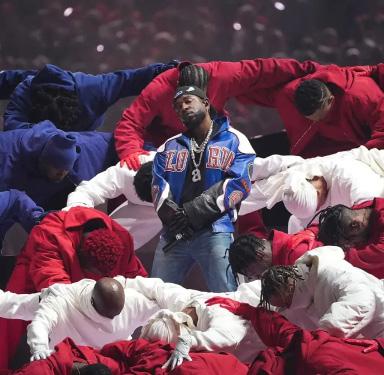
Lamar, SZA and the ensemble of all-Black backup dancers donned a wardrobe of red, white and blue, reinforcing the Americana symbolism that would be present throughout the show. One of the most striking visual elements of the performance was the stage itself, designed as a tic-tac-toe board with video game controller symbols. Actor Samuel L. Jackson appeared as a satirical Uncle Sam, who declared, “This is the great American game,” further hinting at a systemic power imbalance that often treats marginalized communities like players in a rigged system, forced to follow rules they did not create. Uncle Sam has long been a symbol of American patriotism, but he was now a representation of the systematic criticisms often thrown at these communities. He was not a beacon of freedom, but an overseer and a reminder of the scrutiny, control and expectations placed on Black Americans.
Before “squabble up,” Lamar proclaimed, “The revolution about to be televised, you picked the right time but the wrong guy.” This was a direct inversion of the famous phrase from poet and musician Gil Scott-Heron’s 1971 work, “The Revolution Will Not Be Televised,” which suggested that true change could not happen through corporate-controlled media but rather through direct actions. Lamar’s declaration challenged that idea as he was using one of the biggest televised platforms in the world to bring political resistance into the mainstream. His performance also reflected the power of social media by exposing racial injustice, police brutality and economic disparity, making it impossible to be ignored. “The right time” suggests that the political climate is prime for revolution and accountability, and “the wrong guy” implies that Lamar refuses to be a pawn or spokesperson for empty performative activism. Referring to institutions that tend to embrace Black artists only when it is commercially viable but reject them and their messages when they question the status quo, Lamar’s line could be rejecting this selective support.
After “squabble up,” Uncle Sam cuts in, disapproving, “Too loud, too reckless, too ghetto. Mr. Lamar, do you really know how to play the game? Then, tighten up!” This led to a performance of “HUMBLE.,” where Lamar and his male dancers initially formed a tightly knit American flag, only for the flag to be split down the middle moments later. This powerful visual could represent both the divided state of America and the way America was built on the unrecognized labor of Black Americans. This is further referenced shortly before the penultimate song, “Not Like Us,” in which Lamar said, “40 acres and a mule–this is bigger than the music,” a direct reference to the unfulfilled promise made to formerly enslaved African Americans after the Civil War, which was meant to provide economic independence but was ultimately taken away. Lamar’s use of this imagery was not just a history reference but highlighted the ongoing economic disparities faced by Black Americans today, despite America presenting itself as a land of equal opportunity.
At the end of the final song, “tv off,” Lamar pointed to the camera, grinning, before the camera pans up to reveal the phrase, “GAME OVER,” written in lights in the crowd. This message rejected the rule of the “game” that Uncle Sam referenced throughout the entire performance. It could also be interpreted as a larger message to the establishment–politi cians, corporations and media who manipulate and exploit marginal ized communities while ignoring their struggles.
Unsurprisingly, Lamar’s performance sparked controversy. Some critics on X (formerly Twitter) claimed “[the show] is the regime’s response to Trump’s historic gains with black men.” Others have called it “easily the worst halftime show” they’ve ever seen, and even re ferred to it as a “DEI halftime show.” But in a country still grappling with its past and present, Lamar’s performance was a pointed reminder that music remains one of the most powerful forms of pro test. And on America’s biggest stage, he ensured the nation was listening.

FEB. 21, 2025
SOPHIA
WEISS-GOLDNER Staff Writer
Book bans are surging across the United States at an unprecedented rate. The book bans are not just an attack on literature; banning books threatens intellectual freedom, critical thought and education. In the 2023-24 school year, PEN America, the free speech advocacy group, reported the highest number of book bans nationwide, with over 10,000 books completely removed from school district library collections. This wave of censorship, organized under the Trump administration’s Project 2025 agenda, primarily targets books about race and LGBTQ+ topics.
At the center of this ban is Project 2025, an agenda that promises to dismantle the Department of Education, centralize patriotism values into public schools and ban books written by authors of color, women and LGBT+ writers. By restricting access to books about critical race theory and gender identity, Project 2025 suppresses historical truths and erases marginalized voices from the curriculum.
Perks of Being a Wallflower” by Stephen Chbosky and “The Color Purple” by Alice Walker. Organizations like Moms for Liberty and Project 2025 counterparts exploit parental concerns to justify censorship, positioning discussions about race and gender in schools as inappropriate for students.
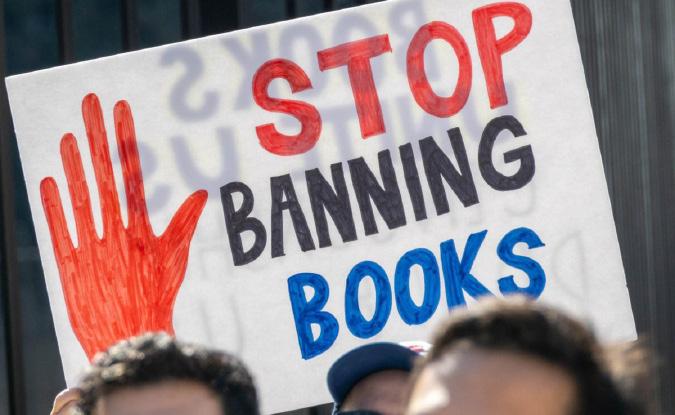
Among the thousands of titles that have been banned are “Gender Queer” by Maia Kobabe, “1984” by George Orwell, “The Handmaid’s Tale” by Margaret Atwood, “To Kill a Mockingbird” by Harper Lee, “The
The intensity of book bans varies from state to state. Florida is leading the censorship movement, with over 4,500 titles banned since 2023. Conversely, some more progressive states, such as Illinois, Minnesota, Maryland and most of New Jersey, have enacted the Freedom to Read Act to prevent these kinds of bans. This law prohibits public libraries and school boards from banning books based on political or ideological differences.
Project 2025 represents the most aggressive federal effort to restrict access to literature in modern history. Under its framework, publishers, teachers and librarians who oppose censorship efforts face professional and legal repercussions. Banning books does not protect children. Instead, it robs them of their right to explore diverse perspectives and think critically.
Removing books that address race, gender and LGBTQ+ identities erase marginalized voices in schools. Depriving students of diverse literature diminishes their civic understanding and capacity for empathy. Project 2025 book bans are part of a broader government agenda to control historical narratives and censor the public’s knowledge of systemic inequalities.
Organizations such as Authors Against Book Bans and the American Library Association are writers, librarians and editors leading the resistance against nationwide book bans by advocating for the fundamental freedom to read. Literature is a powerful tool that enhances the diversity of thought, creates empathy and imparts knowledge. Books are key in shaping our understanding of the world. Authors Against Book Bans defend the freedom to read by implementing banned book clubs and digital library archives to ensure that censored books remain accessible to students and the public.
Allowing the government to ban books without input from teachers restricts students from learning about racism and gender identity in schools. The fact that books about slavery, the Holocaust, LGBTQ+ rights, race and sexism are among those banned is a clear sign of an incredibly dangerous political agenda. Education should empower individuals to think independently, not serve as a tool to manipulate historical truths and erase American history. For many, schools and libraries are often the only places where they have access to books that reflect their identities and heritage.
The banning of books is inherently a banning of intellectual freedom, education and democracy itself. Allowing these book bans to continue sets a dangerous precedent for the future of education and free thought in our country. It is imperative to resist Project 2025’s
Give me your tired, your poor—unless ICE gets to
FEB. 5, 2025
SHEILA RAFIZADEH Assistant Op/Ed Editor
Give me your tired, your poor, your huddled masses yearning to breathe free. The Statue of Liberty stands tall in New York Harbor, a beacon of hope for immigrants seeking a better life. For centuries, people from around the world have come to America, believing in its promise of freedom, opportunity and safety. But today, that promise is being eroded by a wave of anti-immigrant policies that threaten not just the undocumented but the very soul of this nation.
Since returning to office, President Donald Trump has reignited his administration’s hardline stance on immigration, launching mass deportation raids across major U.S. cities. Immigration Enforcement Operation (ICE), once restricted in its actions, can now freely enter schools, hospitals and neighborhoods. The agency has been given a mandate to increase its arrest quotas, leading to thousands being detained—many of whom have committed no crime beyond seeking refuge. The crackdown is not just targeting those with criminal records but sweeping up law-abiding immigrants, asylum seekers and families who have built lives in this country.
only legally dubious but fundamentally un-American. The right to citizenship by birth is a cornerstone of American democracy, ensuring that no child born here is stateless or treated as an outsider in their own country.
As the child of immigrants, I can’t help but imagine what my family would do if we were told to abandon the life we’ve spent decades building and return to a place that is no longer home. For many immigrants, going back is not an option.
The countries they have fled are often plagued by violence, economic hardship and political turmoil. To deport them is to sentence them to a life of suffering.
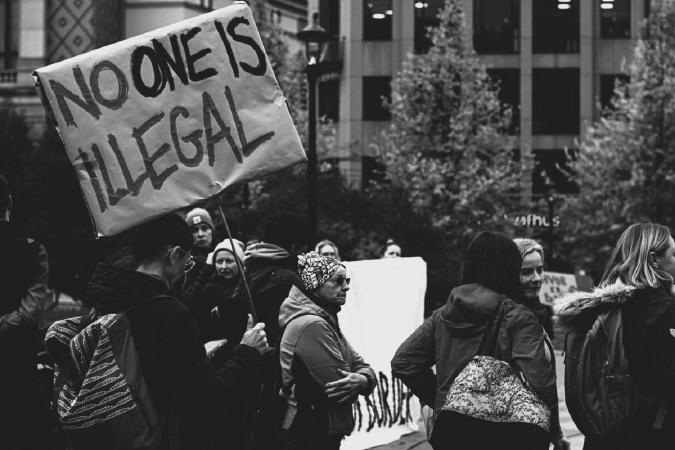
The consequences are dire. Families are being torn apart. Children are being pulled out of schools out of fear that their parents won’t be home when they return. People are avoiding hospitals, even when they need urgent medical care. Small businesses, many of them immigrant-owned, are suffering as customers and workers alike vanish overnight. Despite the administration’s claims that these policies target criminals, the reality is that they are instilling widespread fear and chaos within immigrant communities.
Even more alarming is the Trump administration’s attempt to dismantle birthright citizenship. This move directly challenges the 14th Amendment, which guarantees that all persons born on U.S. soil are citizens. Eighteen states have already sued to block the executive order, recognizing that this attack on the Constitution is not





The lack of empathy in this debate is staggering. When singer Selena Gomez, who is half Mexican, expressed her sorrow over the attacks on immigrants, she was met with backlash, losing over 700,000 followers. She later deleted her video, posting: “Apparently it’s not okay to show empathy for people.” This reaction underscores a cruel reality—many Americans simply do not care because they are unaffected by this issue. But an injustice against one group of people is an injustice against us all.
America was never meant to be a nation of one singular identity. It was “discovered” by European immigrants, built on the labor of enslaved Africans and rests on land stolen from Indigenous peoples. The very foundation of this country is one of migration, struggle and resilience. To now turn our backs on immigrants, to vilify them and strip them of their rights, is a betrayal of our own history.
It’s time to stop voting solely based on personal identity and privilege. Immigration policy should not be dictated by fear or self-interest but by compassion and justice. Those who support these raids and draconian policies must recognize that the leader they endorse is not just governing for them—he is making decisions that shape the entire nation. The Statue of Liberty does not stand in New York Harbor as a relic of the past; she is a reminder of what this country represents. We must decide whether we will continue to honor her message or turn our backs on it forever.
Capricorn,thisastrologicalseason isguidingyoutosetstrong boundariesregardinghow youspendyourtime. Whereyoumayfeelhistoricallyenabledto overworkyourselfto reapthebenefits, Scorpioseason invitesyoutonolongerfeel obligatedtodothisandinsteadbefirmwith
Adventure calls for you, Sagittarius! During Aries season, say “yes” to everything you get invited to! You may discover people, places, and hobbies that you love that you would’ve never expected.
Scorpio,ifyouhave time,acreativeideaduringthis Whiledonotshutitdown! itmayfeelnormalcasetoanticipatetheworst scenario,doors andareopeningforyou themyoudon’twant toshut.

ambiguouswillbeaskedtoletgoofyour instinctwhenit comesto decisionmakofing.Welcometheideachoicesbeingfirminyour andcommittingtothem.


yourtowelcomeAries,season! time,thisDuringinnateyour andboldnesstakingforknack initiative highlybewill rewarded.instayideasletDon’tyour becomehead, them instead.

Aquarius, thisAries seasonis expectingyoutospeakyourtruth ratherthan compromise with others. You never know who elsein the roommayfeelthesameway,sobethe onewho changes thestatusquo. time,thisduringCancer, upflaremayemotionsyour Protectnormal.thanmore thisduringinstinctsyour theonstrayandtime, nottocautionofside passion.withlead thisduringTaurus,passwillsunthetime twelfthyourthroughhouse. greataisThisbreakataketotimefrom naturalthestressors -everyof life.day though you are the natural dreamer of the astrological signs, Aries is asking you to also instigate these dreams and make actionable plans for them to manifest into reality.
Aries season asks you to take note of the fiery energy in the atmosphere, and ensure you watch your words. While you may be tempted to speak before you think, remember that not every battle is worth -choos ing.

Virgo, during this time it may feel like chaos is beginning to intertwine with your careful nature. This is a good time to let go of your need for perfection, and embrace flaws instead. timethisinLeo, period findwillyou more people thewithyoutodrawnare ignited fromspark Aries butseason, remember notthat everyone should have access you.to presYourisence sacred!


